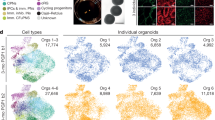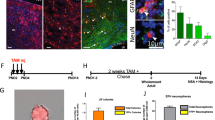Abstract
Limited experimental access to the central nervous system (CNS) is a key problem in the study of human neural development, disease, and regeneration. We have addressed this problem by generating neural chimeras composed of human and rodent cells. Fetal human brain cells implanted into the cerebral ventricles of embryonic rats incorporate individually into all major compartments of the brain, generating widespread CNS chimerism. The human cells differentiate into neurons, astrocytes, and oligodendrocytes, which populate the host fore-, mid-, and hindbrain. These chimeras provide a unique model to study human neural cell migration and differentiation in a functional nervous system.
This is a preview of subscription content, access via your institution
Access options
Subscribe to this journal
Receive 12 print issues and online access
$209.00 per year
only $17.42 per issue
Buy this article
- Purchase on Springer Link
- Instant access to full article PDF
Prices may be subject to local taxes which are calculated during checkout






Similar content being viewed by others
References
Weiss, S., Reynolds, B.A., Vescovi, A.L., Morshead, C., Craig, C.G., and van der Kooy, D. 1996. Is there a neural stem cell in the mammalian forebrain? Trends Neurosci. 19: 387–393.
McKay, R.D.G. 1997. Stem cells in the central nervous system. Science 276: 66–71.
Sabaté, O., Horellou, P., Vigne, E., Colin, P., Perricaudet, M., Buc-Caron, M.H. et al. 1995. Transplantation to the rat brain of human neural progenitors that were genetically modified using adenoviruses. Nat. Genet. 9: 256–260.
Buc-Caron, M.H. 1995. Neuroepithelial progenitor cells explanted from human fetal brain proliferate and differentiate in vitro. Neurobiol. Dis. 2: 37–47.
Murray, K. and Dubois-Dalcq, M. 1997. Emergence of oligodendrocytes from human neural spheres. J. Neurosci. Res. 50: 146–156.
Brüstle, O., Maskos, U., and McKay, R.D.G. 1995. Host-guided migration allows targeted introduction of neurons into the embryonic brain. Neuron 15: 1275–1285.
Campbell, K., Olsson, M., and Björklund, A. 1995. Regional incorporation and site-specific differentiation of striatal precursors transplanted to the embryonic forebrain ventricle. Neuron 15: 1259– 1273.
Brüstle, O., Spiro, C.A., Karram, K., Choudhary, K., Okabe, S., and McKay, R.D.G. 1997 . In vitro-generated neural precursors participate in mammalian brain development. Proc. Natl. Acad. Sci. USA 94: 14809–14814.
Olsson, M., Bjerregaard, K., Winkler, C., Gates, M., Björklund, A., and Campbell, K. 1998. Incorporation of mouse neural progenitors transplanted into the rat embryonic forebrain is developmentally regulated and dependent on regional and adhesive properties. Eur. J. Neurosci. 10: 71–85.
Reynolds, B.A. and Weiss, S. 1992. Generation of neurons and astrocytes from isolated cells of the adult mammalian central nervous system. Science 255: 1707 –1710.
Brüstle, O., Cunningham, M., Tabar, V., and Studer, L. 1997. Experimental transplantation in the embryonic, neonatal, and adult mammalian brain, pp. 3.10.11–13.10.28 in Current protocols in neuroscience. Crawley, J., Gerfen, C., McKay, R.D.G., Rogawski, M., Sibley, D., and Skolnick, P. (eds.). John Wiley, New York.
Rubin, C.M., Houck, C.M., Deininger, P.L., Friedmann, T., and Schmid, C.W. 1980. Partial nucleotide sequence of the 300-nucleotide interspersed repeated human DNA sequences. Nature 284: 372– 374.
Fishell, G. 1995. Striatal precursors adopt cortical identities in response to local cues. Development 121: 803–812.
Lim, D.A., Fishell, G.J., and Alvarez-Buylla, A. 1997. Postnatal mouse subventricular zone neuronal precursors can migrate and differentiate within multiple levels of the developing neuraxis. Proc. Natl. Acad. Sci. USA 94: 14832–14836.
Brophy, P.J., Boccaccio, G.L., and Colman, D.R. 1993. The distribution of myelin basic protein mRNAs within myelinating oligodendrocytes. Trends Neurosci. 16: 515–521.
Cammer, W. and Zhang, H. 1992. Localization of Pi class glutathione-S-transferase in the forebrains of neonatal and young rats: evidence for separation of astrocytic and oligodendrocytic lineages. J. Comp. Neurol. 321: 40– 45.
Fouquet, F., Zhou, J.M., Ralston, E., Murray, K., Troalen, F., Magal, E. et al. 1997. Expression of the adrenoleukodystrophy protein in the human and mouse central nervous system. Neurobiol. Dis. 3: 271– 285.
Trojanowski, J.Q., Mantione, J.R., Lee, J.H., Seid, D.P., You, T., Inge, L.J. et al. 1993. Neurons derived from a human teratocarcinoma cell line establish molecular and structural polarity following transplantation into the rodent brain. Exp. Neurol. 122: 283–294.
Wictorin, K., Brundin, P., Gustavii, B., Lindvall, O., and Björklund, A. 1990. Reformation of long axon pathways in adult rat central nervous system by human forebrain neuroblasts. Nature 347: 556– 558.
Wictorin, K., Brundin, P., Sauer, H., Lindvall, O., and Björklund, A. 1992. Long distance directed axonal growth from human dopaminergic mesencephalic neuroblasts implanted along the nigrostriatal pathway in 6-hydroxydopamine lesioned adult rats. J. Comp. Neurol. 323: 475–494.
Svendsen, C.N., Caldwell, M.A., Shen, J., ter Borg, M.G., Rosser, A.E., Tyers, P. et al. 1997. Long-term survival of human central nervous system progenitor cells transplanted into a rat model of Parkinson's disease. Exp. Neurol. 148: 135–146.
Ono, K., Yasui, Y., Rutishauser, U., and Miller, R.H. 1997. Focal ventricular origin and migration of oligodendrocyte precursors into the chick optic nerve. Neuron 19: 283–292.
Levison, S.W., Chuang, C., Abramson, B.J., and Goldman, J.E. 1993. The migrational patterns and developmental fates of glial precursors in the rat subventricular zone are temporally regulated. Development 119: 611–622 .
Alvarez-Buylla, A. and Lois, C. 1995. Neuronal stem cells in the brain of adult vertebrates. Stem Cells 13: 263–272.
Craig, C.G., Tropepe, V., Morshead, C.M., Reynolds, B.A., Weiss, S., and van der Kooy, D. 1996. In vivo growth factor expansion of endogenous subependymal neural precursor cell populations in the adult mouse brain. J. Neurosci. 16: 2649– 2658.
Kuhn, H.G., Winkler, J., Kempermann, G., Thal, L.J., and Gage, F.H. 1997. Epidermal growth factor and fibroblast growth factor-2 have different effects on neural progenitors in the adult rat brain. J. Neurosci. 17: 5820–5829.
Gumpel, M., Lachapelle, F., Gansmuller, A., Baulac, M., Baron van Evercooren, A., and Baumann, N. 1987. Transplantation of human embryonic oligodendrocytes into shiverer brain. Ann. NY Acad. Sci. 495: 71–85.
Seilhean, D., Gansmüller, A., Baron-Van Evercooren, A., Gumpel, M., and Lachapelle, F. 1996 . Myelination by transplanted human and mouse central nervous system tissue after long-term cryopreservation. Acta. Neuropathol. 91: 82–88.
Duncan, I.D., Grever, W.E., and Zhang, S.C. 1997. Repair of myelin disease: strategies and progress in animal models. Mol. Med. Today 3: 554–561.
Groves, A.K., Barnett, S.C., Franklin, R.J.M., Crang, A.J., Mayer, M., Blakemore, W.F. et al. 1993. Repair of demyelinated lesions by transplantation of purified O-2A progenitor cells. Nature 362: 453–455.
Tontsch, U., Archer, D.R., Dubois-Dalcq, M., and Duncan, I.D. 1994. Transplantation of an oligodendrocyte cell line leading to extensive myelination. Proc. Natl. Acad. Sci. USA 91: 11616–11620.
Blakemore, W.F., Olby, N.J., and Franklin, R.J.M. 1995. The use of transplanted glial cells to reconstruct glial environments in the CNS. Brain Pathol. 5: 443–450.
Lachapelle, F. 1995. Glial transplants: an in vivo analysis of extrinsic and intrinsic determinants of dysmyelination in genetic variants. Brain Pathol. 5: 289–299.
Duncan, I.D. and Milward, E.A. 1995. Glial cell transplants: experimental therapies of myelin diseases. Brain Pathol. 5: 301–310.
Nave, K.A. and Boespflug-Tanguy, O. 1996. X-linked developmental defects of myelination: from mouse mutants to human genetic diseases. The Neuroscientist 2: 33–43.
Dunnett, S.B. and Björklund, A. 1992. Neural transplantation. a practical approach. Oxford University Press, New York.
Lendahl, U., Zimmermann, L.B., and McKay, R.D.G. 1990. CNS stem cells express a new class of intermediate filament protein. Cell 60: 585–595.
Acknowledgements
We thank Y. Maeda for providing the adenoviral vector and J. Trojanowski and P. Aubourg for the HO14 and ALDP antibodies, respectively. We would also like to thank John Rajan and his group for coordinating the tissue transfer and the Myelin Project for support to M.D.-D. and K.M.. Roberto Bruzzone, Kimberly Jones, and Bernard Rogister critically read the manuscript.
Author information
Authors and Affiliations
Corresponding author
Rights and permissions
About this article
Cite this article
Brüstle, O., Choudhary, K., Karram, K. et al. Chimeric brains generated by intraventricular transplantation of fetal human brain cells into embryonic rats. Nat Biotechnol 16, 1040–1044 (1998). https://doi.org/10.1038/3481
Received:
Accepted:
Issue Date:
DOI: https://doi.org/10.1038/3481
This article is cited by
-
Acceptability of neural stem cell therapy for cerebral palsy: survey of the Australian cerebral palsy community
Stem Cell Research & Therapy (2023)
-
Immune-tolerance to human iPS-derived neural progenitors xenografted into the immature cerebellum is overridden by species-specific differences in differentiation timing
Scientific Reports (2021)
-
Neural precursor cells form integrated brain-like tissue when implanted into rat cerebrospinal fluid
Communications Biology (2018)
-
Stem cells and interspecies chimaeras
Nature (2016)



